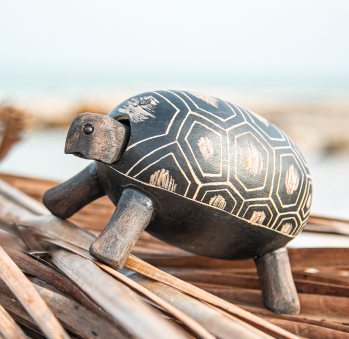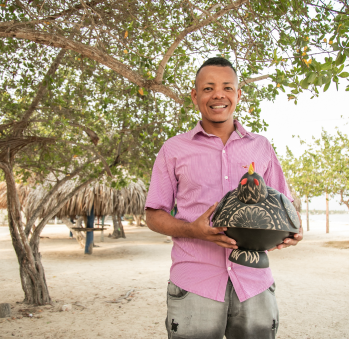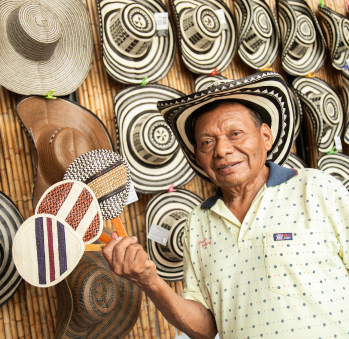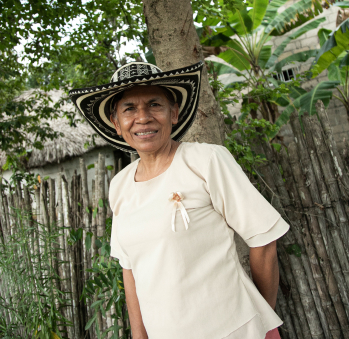Leider Guerrero
Workshop: Totumar
Craft: Trabajo en no maderables
Trail: Cordoba Route
Location: San Antero, Córdoba
While Leider was born in Tumaco, he regards San Antero as his true hometown. Not just due to the calm years of his adolescence spent here, but also because it’s the place that shaped him into the craftsman he is today. This man, now in his mid-thirties, speaks with the calmness of someone who possesses abundant expertise in his hands. And indeed, he does: he has been exploring the art of totumo carving for nearly two decades.
The times when his family lived in fear now feel distant. He recalls that despite living near Tumaco’s port held a beauty filled up by the sea, that bliss was overshadowed by underlying violence. His parents never explicitly conveyed their anxieties about the potential threat to his teenage years, yet both he and his sibling sensed the tension. Being exposed to forced recruitment by an illegal armed group was a common occurrence. When there was no escape and danger became too close, they made the decision to flee. As his mother was from Córdoba, returning to San Antero was the safest choice. And so, they did. At the age of 14, he bid farewell to friends and loved ones, embarking on a new life in an unfamiliar landscape. The Sinú river and the picturesque mangroves provided companionship during this fresh start.
Speaking of those times seems like recounting a different life, as his description of this now-established life is filled with only positive words. In San Antero, often referred to as the jewel in the crown due to its beauty, he uncovered his inherent talent. Initially visiting the Totumo Museum as part of an assignment, he soon found himself spending his mornings there before school, earning 6,000 pesos for the week’s treats. Before long, however, he recognized that this place was becoming increasingly important for him. In hindsight, he’s thankful for the discipline instilled—along with the teacher’s scolds—and the humility he gained there. He undertook a range of tasks, from sweeping the museum’s floors to learning everything about the totumo. This period of education spanned six years of orderly effort.
He takes pleasure in gathering the fruits he will later shape. He’s renowned in the “”pajas,”” the local term for the town’s estates, and has permission to enter and scavenge the totumos that will soon transform into a guacharaca or a native animal such as a morrocoy, sea turtle, armadillo, parrot, or hummingbird. Beyond his wife and two daughters, his most cherished treasures are his three knives. He crafted them in distinct sizes, tailored for carving patterns onto the totumo’s skin. His precision as a craftsman has allowed him to witness the evolution of the craft over time, adopting improved procedures—more health-conscious ones, at least. In the past, resourceful artisans would either smoke the totumos or bury them in the earth for extended periods to darken their crust. The former practice was unhealthy due to the inhaled smoke, while the latter resulted in totumos with an unpleasant odor.
Consequently, his learning process has had to do with finding more effective methods. He firmly believes that contemporary craftwork should be both functional and aesthetic. His task is to find a balance between these two needs and to mentor the upcoming generations of artisans. Presently, his focus centers on his youngest daughter, María José. He senses the same calling he felt in his hands when he was a boy, within her.
Craft
















Artisans along the way
Artisans along the way
No puede copiar contenido de esta página




























































